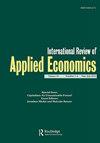Population and economic growth in developed countries
IF 1.6
Q3 ECONOMICS
引用次数: 0
Abstract
ABSTRACT The relationship between population growth and economic growth is examined. Evidence is provided on the direction of causality between population and GDP in five industrialized countries (US, UK, Germany, France, and Italy) for the periods 1820–1938 and 1950–2016. Using Toda-Yamamoto Granger causality tests and Sims causality test it was found that the direction of causality during the former period was from Population to GDP or bidirectional while for the latter period, it was from GDP to population. It is also shown that during the second period per capita GDP was almost double relative to the first period. We argue that the difference may be partly explained by the direction of causality between the two variables. In the 1820–1938 period, the direction of causality is probably due to the large family model that prevailed in that period that led to rapid population growth. For the 1950–2016 period it is probably the rapid economic growth that followed the Second World War and motivated large migration flows to the developed countries we examined.发达国家的人口与经济增长
研究了人口增长与经济增长之间的关系。提供了1820–1938年和1950–2016年期间五个工业化国家(美国、英国、德国、法国和意大利)人口与GDP之间因果关系方向的证据。利用Toda Yamamoto Granger因果关系检验和Sims因果关系检验发现,前一时期的因果关系方向是从人口到GDP或双向的,而后一时期则是从GDP到人口的。研究还表明,在第二个时期,人均国内生产总值几乎是第一个时期的两倍。我们认为,这种差异可能部分由两个变量之间的因果关系方向来解释。在1820–1938年期间,因果关系的方向可能是由于该时期盛行的大家庭模式导致了人口的快速增长。在1950年至2016年期间,可能是第二次世界大战后的快速经济增长推动了大量移民流向我们研究的发达国家。
本文章由计算机程序翻译,如有差异,请以英文原文为准。
求助全文
约1分钟内获得全文
求助全文
来源期刊

International Review of Applied Economics
ECONOMICS-
CiteScore
4.30
自引率
4.50%
发文量
37
期刊介绍:
International Review of Applied Economics is devoted to the practical applications of economic ideas. Applied economics is widely interpreted to embrace empirical work and the application of economics to the evaluation and development of economic policies. The interaction between empirical work and economic policy is an important feature of the journal. The Journal is peer reviewed and international in scope. Articles that draw lessons from the experience of one country for the benefit of others, or that seek to make cross-country comparisons are particularly welcomed. Contributions which discuss policy issues from theoretical positions neglected in other journals are also encouraged.
 求助内容:
求助内容: 应助结果提醒方式:
应助结果提醒方式:


